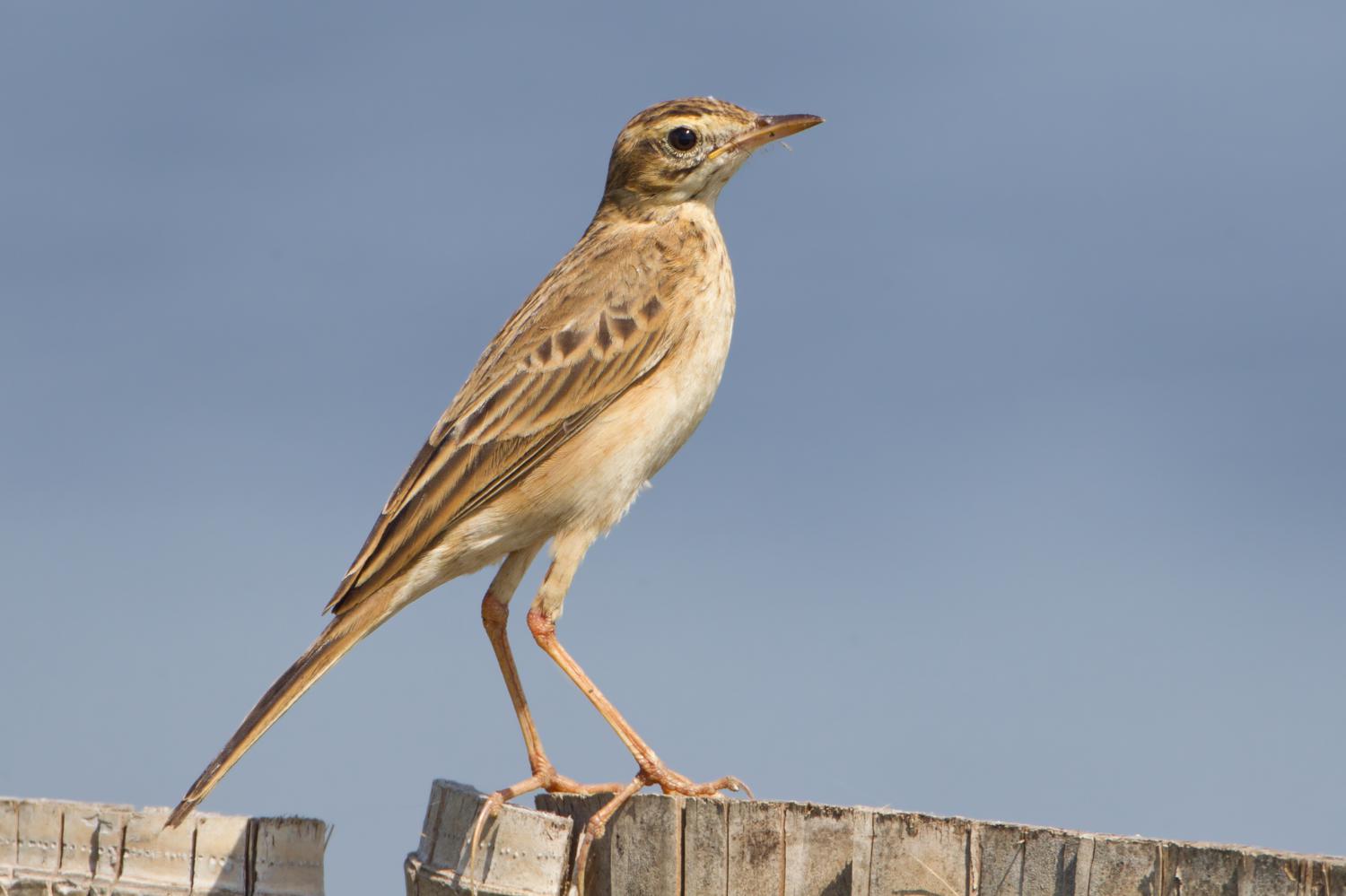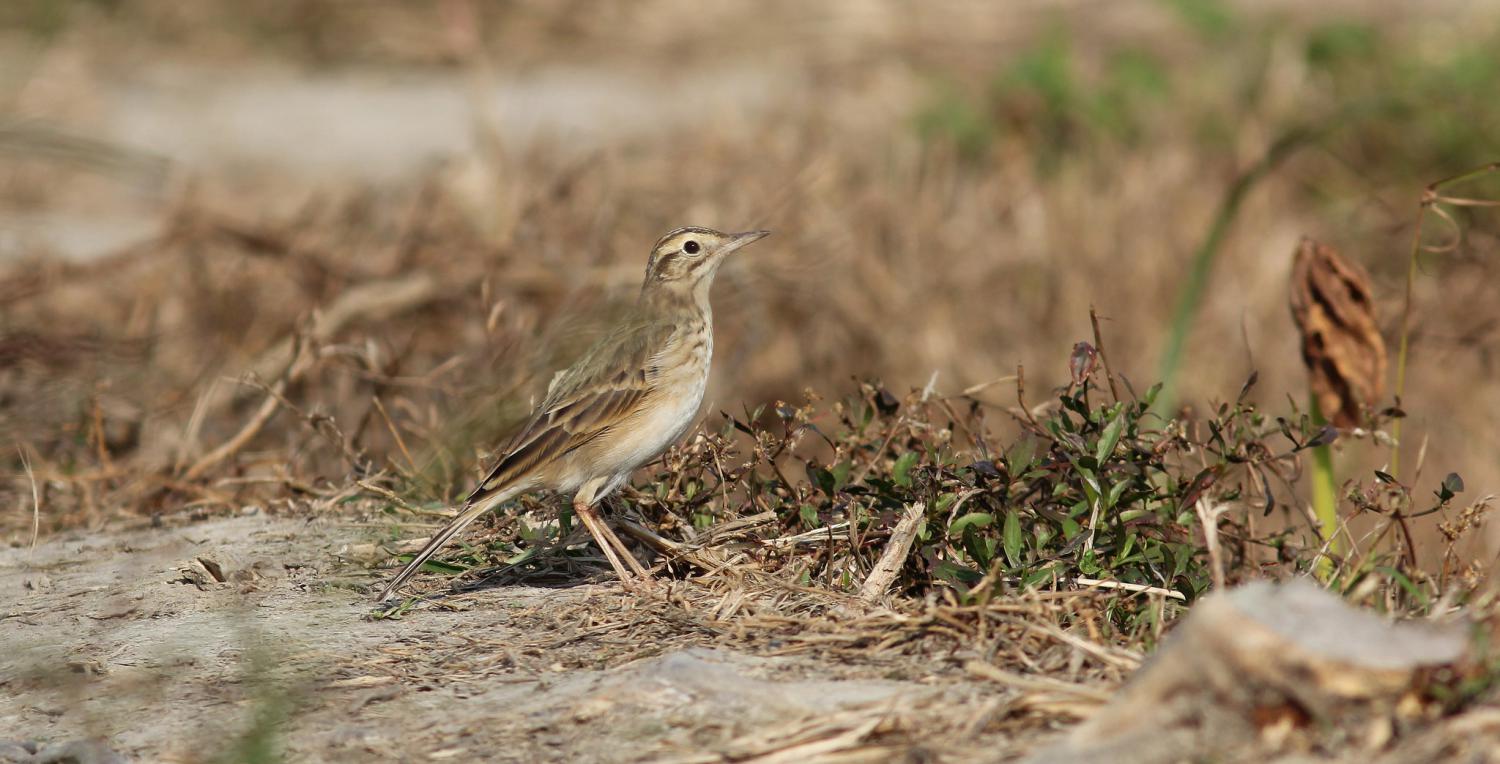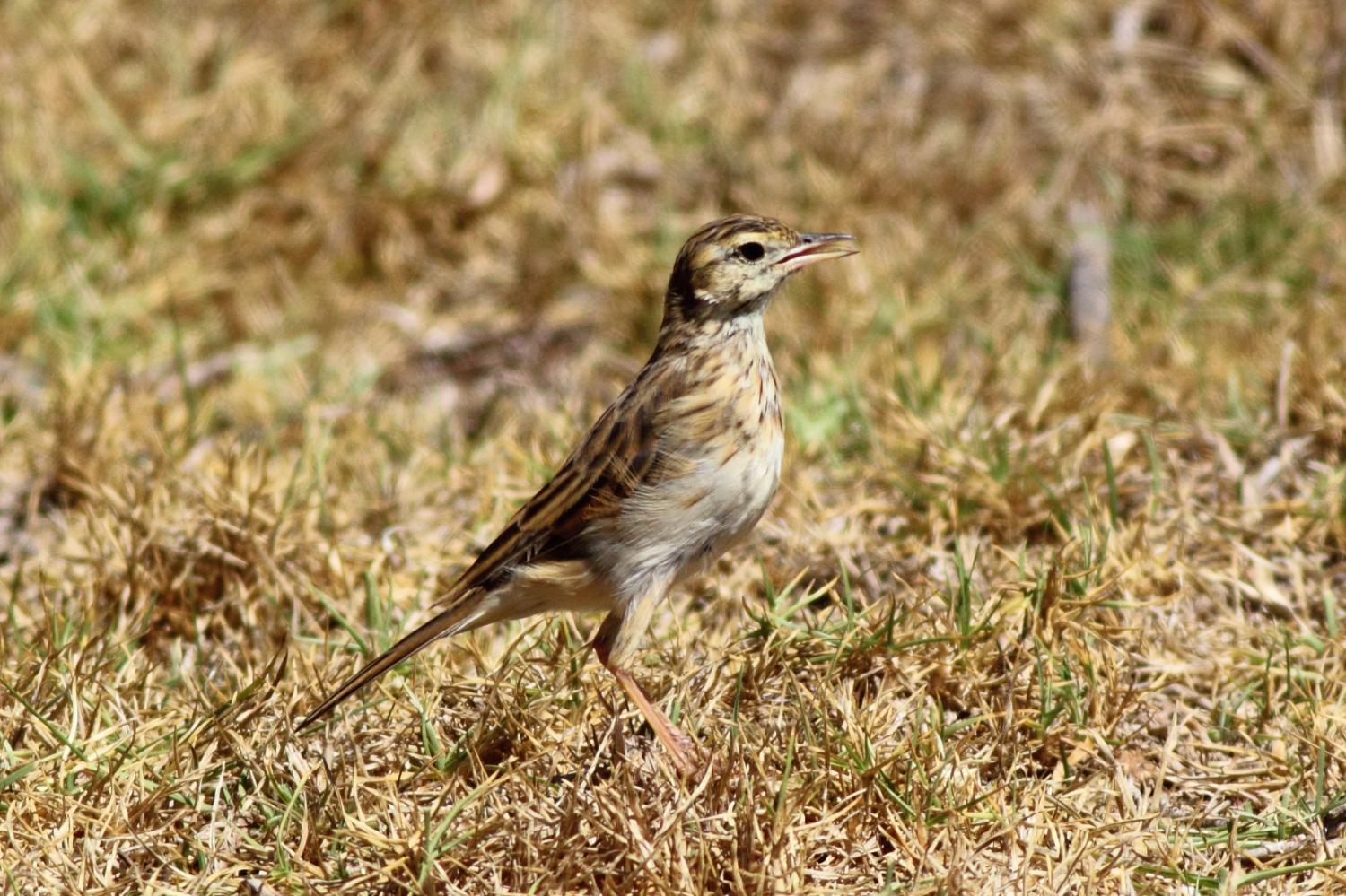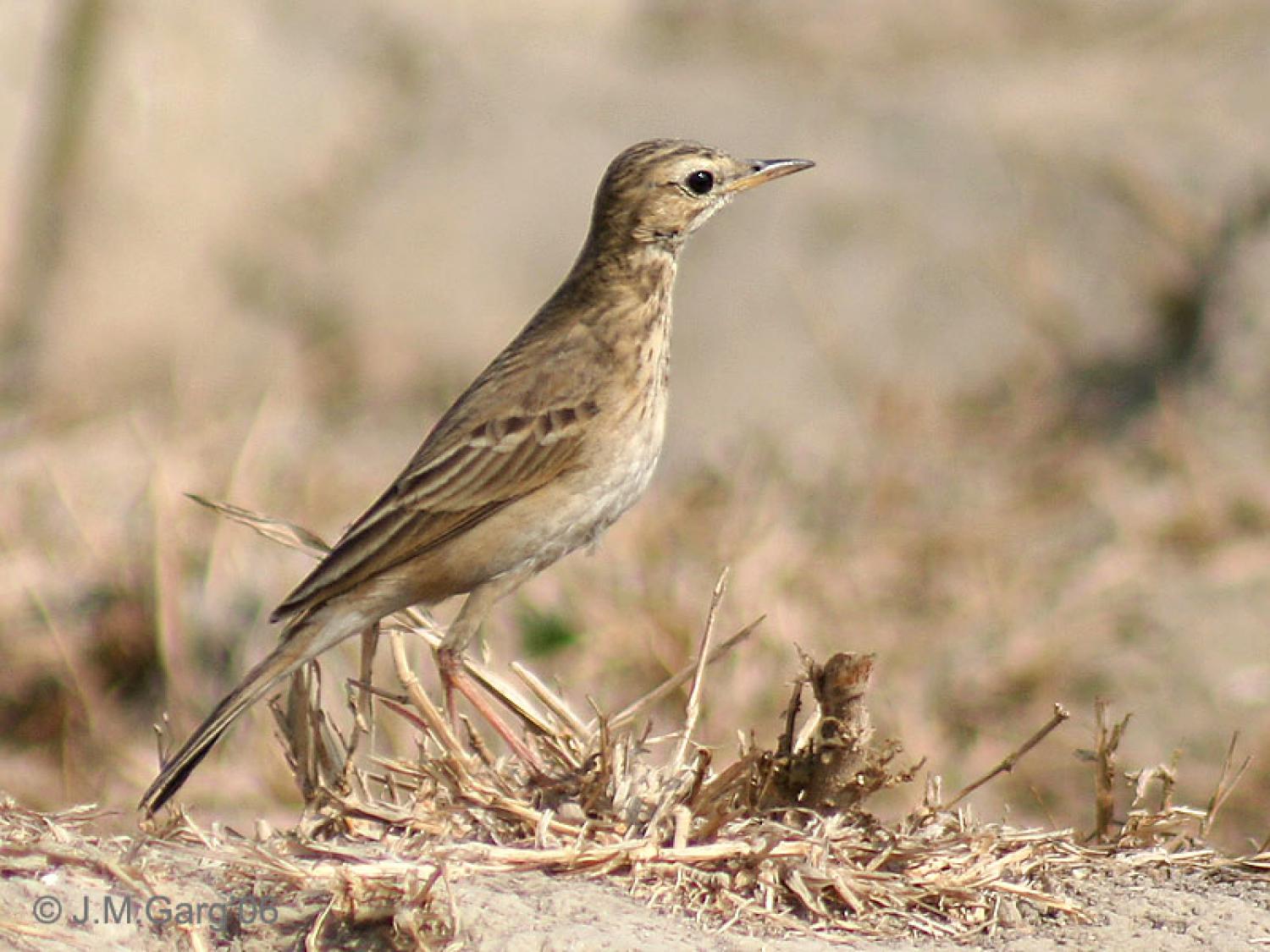Species of Thailand
Richard's pipit
Anthus richardi
Louis Jean Pierre Vieillot, 1818
In Thai: นกเด้าดินทุ่งใหญ่
Richard's pipit (Anthus richardi) is a medium-sized passerine bird which breeds in open grasslands in the East Palearctic. It is a long-distance migrant moving to open lowlands in the Indian subcontinent and Southeast Asia. It is a rare but regular vagrant to western Europe.
The genus name Anthus is the Latin name for a small bird of grasslands. The English name and richardi are for the French naturalist Charles Richard (1745–1835), director of postal services at Lunéville and friend of Francois Levaillant.
It belongs to the pipit genus Anthus in the family Motacillidae. It was formerly lumped together with the Australasian, African, mountain and paddyfield pipits in a single species: Richard's pipit, Anthus novaeseelandiae. These pipits are now commonly considered to be separate species although the African and paddyfield pipits are sometimes treated as part of A. richardi.
Description
This is a large pipit, 17–20 cm in length, with a weight of 25–36 g and a wingspan of 29 to 33 cm. It is a slender bird which often stands very upright. It has long yellow-brown legs, a long tail with white outer-feathers and a long dark bill with a yellowish base to the lower mandible. The hindclaw is long and fairly straight. It is an undistinguished-looking species on the ground, mainly brown above and pale below. There are dark streaks on the upperparts and breast while the belly and flanks are plain. The face is strongly marked with pale lores and supercilium and dark eyestripe, moustachial stripe and malar stripe. There are two wingbars formed by pale tips to the wing-coverts.
There is some variation between the different subspecies. A. r. sinensis is slightly smaller than the nominate race with less streaking above. A. r. centralasiae is larger with more sand-coloured upperparts. A. r. dauricus has more streaking above.
Its flight is strong and undulating, and it gives a characteristic explosive "shreep" call, somewhat similar to the chirp of a house sparrow. The song is a repeated series of monotonous buzzy notes given in an undulating song-flight.
Some care must be taken to distinguish this from other large pipits which winter or are resident in the area, such as Blyth's pipit and paddyfield pipit. Blyth's pipit has a shorter bill, legs and tail, a shorter and more curved hindclaw, less white on the tail and more streaking on the upperparts. In adult birds, the median wing-coverts have blunt-ended dark centres whereas in Richard's pipit the dark centres become pointed towards the tip of the feather. The call of Blyth's pipit call is quieter and less harsh. Paddyfield pipit is smaller than Richard's pipit with a shorter bill and tail, less streaking on the breast and a quieter call.
Distribution and habitat
Richard's pipit breeds in southern Siberia, Mongolia, parts of Central Asia and in northern, central and eastern China. It migrates south to winter in the Indian subcontinent and South-east Asia with records as far south as Sri Lanka, Singapore and northern Borneo. It is a scarce passage migrant in Korea and Japan. A small part of the population regularly moves west in autumn and birds have been recorded from most countries in Europe, the Middle East and North Africa. It is seen annually between September and November at coastal watchpoints in areas such as Britain, the Netherlands and Scandinavia with occasional birds appearing in spring. A few overwinter in countries like Spain, Portugal and Morocco.
Behaviour and ecology
It is a bird of open country, particularly flat lowland areas. It inhabits grassland, steppe and cultivated land, preferring more fertile, moist habitats. In Europe it is most often recorded on headlands and islands. It occurs alone or in small groups.
Like other pipits, this species is insectivorous. It mainly feeds on the ground and will also make short flights to catch flying insects. A few seeds are also eaten.
The nest is made of grass or moss and is built on the ground under a grass tussock.
This article uses material from Wikipedia released under the Creative Commons Attribution-Share-Alike Licence 3.0. Eventual photos shown in this page may or may not be from Wikipedia, please see the license details for photos in photo by-lines.
Category / Seasonal Status
Wiki listed status (concerning Thai population): Winter visitor
BCST Category: Recorded in an apparently wild state within the last 50 years
BCST Seasonal status: Non-breeding visitor
Scientific classification
- Kingdom
- Animalia
- Phylum
- Chordata
- Class
- Aves
- Order
- Passeriformes
- Family
- Motacillidae
- Genus
- Anthus
- Species
- Anthus richardi
Common names
- English: Richard's pipit
- Thai: นกเด้าดินทุ่งใหญ่
Conservation status

Least Concern (IUCN3.1)
Photos
Please help us review the bird photos if wrong ones are used. We can be reached via our contact us page.
Range Map
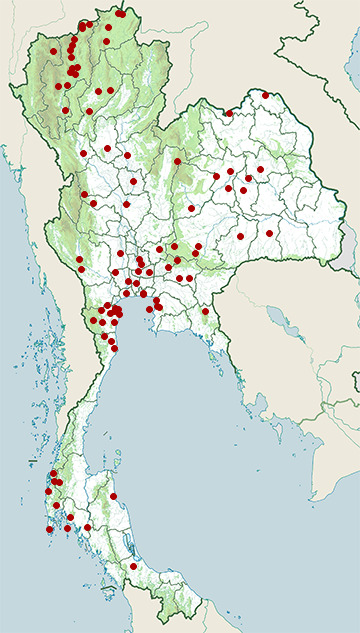
- Ban Laem District, Phetchaburi
- Ban Lat District, Phetchaburi
- Ban Phai District, Khon Kaen
- Bang Pa In District, Phra Nakhon Si Ayutthaya
- Bang Phra Non-Hunting Area
- Bang Pu Recreation Centre
- Bangkok Province
- Borabue District, Maha Sarakham
- Bueng Boraped Non-Hunting Area
- Chatturat District, Chaiyaphum
- Chiang Dao District, Chiang Mai
- Chiang Dao Wildlife Sanctuary
- Chiang Saen District, Chiang Rai
- Doi Inthanon National Park
- Doi Lo District, Chiang Mai
- Doi Pha Hom Pok National Park
- Doi Suthep - Pui National Park
- Doi Tao District, Chiang Mai
- Erawan National Park
- Fang District, Chiang Mai
- Hat Yai District, Songkhla
- Hua Hin District, Prachuap Khiri Khan
- Huai Chorakhe Mak Reservoir Non-Hunting Area
- Kabin Buri District, Prachinburi
- Kaeng Khoi District, Saraburi
- Kaeng Krachan District, Phetchaburi
- Kaeng Krachan National Park
- Kamphaeng Saen District, Nakhon Pathom
- Kantharawichai District, Maha Sarakham
- Khao Nang Phanthurat Forest Park
- Khao Phra - Bang Khram Wildlife Sanctuary
- Khao Sam Roi Yot National Park
- Khao Soi Dao Wildlife Sanctuary
- Khao Sok National Park
- Khao Yai National Park
- Khao Yoi District, Phetchaburi
- Khura Buri District, Phang Nga
- Ko Sichang District, Chonburi
- Kut Thing Non-Hunting Area
- Laem Pak Bia
- Mae Ai District, Chiang Mai
- Mae Mo District, Lampang
- Mae Poen District, Nakhon Sawan
- Mae Rim District, Chiang Mai
- Mae Taeng District, Chiang Mai
- Mae Wong National Park
- Mueang Chiang Mai District, Chiang Mai
- Mueang Chiang Rai District, Chiang Rai
- Mueang Chonburi District, Chonburi
- Mueang Kalasin District, Kalasin
- Mueang Khon Kaen District, Khon Kaen
- Mueang Krabi District, Krabi
- Mueang Lampang District, Lampang
- Mueang Nong Khai District, Nong Khai
- Mueang Phang Nga District, Phang Nga
- Mueang Phetchaburi District, Phetchaburi
- Mueang Phitsanulok District, Phitsanulok
- Mueang Phuket District, Phuket
- Mueang Samut Sakhon District, Samut Sakhon
- Mueang Sukhothai District, Sukhothai
- Mueang Suphanburi District, Suphan Buri
- Mueang Tak District, Tak
- Nam Nao National Park
- Nam Phong National Park
- Nong Bong Khai Non-Hunting Area
- Nong Ya Plong District, Phetchaburi
- Pai District, Mae Hong Son
- Pak Chong District, Nakhon Ratchasima
- Pak Phli District, Nakhon Nayok
- Pak Thale
- Pak Thong Chai District, Nakhon Ratchasima
- Pha Daeng National Park
- Phan District, Chiang Rai
- Phi Phi Islands
- Phra Nakhon Si Ayutthaya District, Phra Nakhon Si Ayutthaya
- Phutthamonthon District, Nakhon Pathom
- Pran Buri District, Prachuap Khiri Khan
- Sai Yok District, Kanchanaburi
- Sakaerat Environmental Research Station
- Samut Prakan Province
- San Sai District, Chiang Mai
- Si Maha Phot District, Prachinburi
- Si Racha District, Chonburi
- Sikhoraphum District, Surin
- Sop Prap District, Lampang
- Sri Phang Nga National Park
- Takua Pa District, Phang Nga
- Taphan Hin District, Phichit
- Tha Sala District, Nakhon Si Thammarat
- Thanyaburi District, Pathum Thani
- Wat Phai Lom & Wat Ampu Wararam Non-Hunting Area
